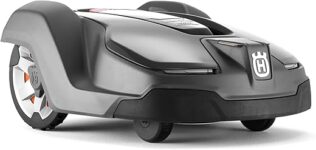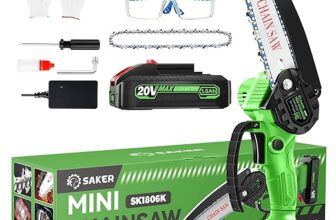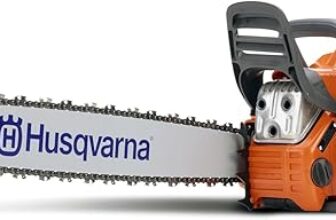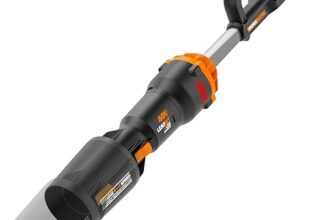
Husqvarna Automower 430X Robotic Mower
Quiet, GPS-guided mowing that trades weekend work for a higher upfront cost and some setup patience.
Weekly lawn maintenance is a time sink and often a noisy, sweaty chore — especially for homeowners with medium to large yards. Traditional mowers can leave patchy coverage on slopes and struggle through narrow passages, so anyone who wants a consistently tidy lawn without sacrificing weekends is looking for a quieter, more reliable solution.
The Husqvarna Automower 430X is a GPS-assisted robotic mower for up to 0.8 acre that aims to do just that. It delivers ultra-quiet operation, automatic return-to-base, smart-home integration, and built-in GPS theft protection; buyers should note the time-consuming boundary-wire installation, occasional app quirks, and the premium upfront cost.
Husqvarna Automower 430X Robotic Mower
It delivers consistently clean cuts with minimal intervention and strong anti-theft features for peace of mind. While installation and occasional app quirks require patience, the result is a near-constant, well-kept lawn without the weekly chore.
Meet Gary: The Husqvarna Automower 430X Robotic Mower
Overview
The Automower 430X is Husqvarna’s premium midsize robotic mower designed for homeowners who want a tidy lawn without weekly manual mowing. It uses GPS-assisted navigation, a boundary wire system, and a compact three-blade cutting head to maintain lawns up to about 0.8 acre. The machine balances autonomous operation with configurable settings via Automower Connect, and it emphasizes quiet, continual trimming rather than infrequent heavy cuts.
Key design and build highlights
What’s in the box and notable specs
| Quick specifications | Detail |
|---|---|
| Area capacity | Up to 0.8 acre (approx. 1,430 sq ft/hr mowing rate) |
| Cutting width | 9.45 inches (three-blade system) |
| Cutting height | Adjustable 0.8″–2.4″ |
| Battery runtime | ~145 minutes per charge (typical, subject to terrain) |
| Max slope handling | Up to 45° on short sections |
Navigation, coverage and mowing behavior
Husqvarna pairs a physical boundary wire with GPS-assisted logic. The boundary wire defines the permitted area and guide wire helps the mower find tricky spots such as long corridors to a far corner. The GPS system improves route planning, reduces missed patches, and enables location tracking if the mower is moved. The Automower intentionally mows in semi-random patterns, which prevents visible stripes and compaction; that behavior differs from straight-line robotic mowers but yields a uniformly maintained lawn.
Installation and setup (what to expect)
Real-world notes:
Battery, runtime and seasonal use
Security, remote management and software
Maintenance and consumables
Maintenance tips:
Who should consider this mower
Limitations and realistic expectations
Final assessment
The Automower 430X is a thoughtfully designed robotic mower that leans into quiet, autonomous lawn care with modern connectivity and strong anti-theft measures. For owners prepared to invest an afternoon into careful boundary installation (or hire it out), the trade-offs are fewer chores and a consistently healthy-looking lawn. It isn’t perfect—installation and app polish can be improved—but its core mowing performance and onboard security features justify its positioning as a premium midsize robotic mower.

“Looking for something about the Husqvarna 430X that you didn’t find in our review? Check out the manual here: Husqvarna 430X Manual”
FAQ
Installation takes patience, not special skills. The owner should plan the layout before digging and place the charging base on level ground close to a power outlet. They will need basic tools (hammer for stakes, wire cutters, connector crimps or screw connectors) and the included wire and pegs.
Complex or irregular yards—many beds, islands, or long guide corridors—take longer and often require trial runs to refine guide-wire routes. For owners who want to save time or avoid mistakes, a landscaper or authorized dealer can install the system or rent a small trencher to speed up burying. After installation, test the boundary with the app or mower and keep a record of wire splices and terminal connections for future maintenance.
It is designed to handle wet conditions and can mow in light to moderate rain. Its sensors stop the blades instantly if lifted or tilted, which helps safety during wet runs.
After wet runs they should wipe and dry the charging contacts and inspect the housing and blades for grass build-up. Excessively wet grass also increases wheel slip and can cause uneven cuts, so consider postponing mowing when the lawn is very wet.
The mower includes anti-theft features: a PIN lock, an audible alarm, and GPS-based location reporting in the companion app. If it is moved, the owner can check the app for the last-known GPS coordinates and trigger the alarm if in range.
Treat these features as deterrents rather than foolproof recovery tools. For added security they should store the mower indoors when not in use, use a visible serial tag, or supplement with cameras and a locked shed.
It is rated to handle short sections up to about 45° and can navigate narrow passages when guided by the wire. That rating covers many garden slopes but is for brief runs rather than long climbs.
Owners should test tricky sections, run the mower when the ground is dry for best traction, and adjust guide-wire paths or use additional guide wires to improve navigation through constrained spaces.
Small steel blades are inexpensive and designed to be replaced frequently for a clean cut. Many users replace blades every 1–3 months depending on mowing frequency, lawn conditions, and whether the blades hit debris.
Signs that the battery needs replacement include noticeably shorter run times, longer charging times, or battery-related error messages. For safety and warranty reasons, battery replacement is often done through an authorized dealer, and old batteries should be recycled properly.
No. The mower uses a semi-random mowing pattern to avoid creating straight-line stripes and to reduce soil compaction. Over time this produces an even-looking lawn rather than the banded appearance from traditional ride-on mowers.
If patches appear they should check blade sharpness, increase mowing frequency, verify that the boundary and guide wires reach tight edges, and ensure the mower can access all lawn areas. These steps usually correct uneven coverage within a few weeks.












Bought this for my 0.6 acre yard and here’s my take:
1) Setup took longer than I expected — the boundary wire routing was fiddly.
2) Once running it’s whisper-quiet and the lawn looks amazing.
3) App can be glitchy sometimes (lost connection once after an update).
4) Anti-theft features are reassuring — GPS tracking gave me peace of mind.
5) Pricey, but I save soooo many weekend hours now. Worth it? For me, yes. 😊
Totally jealous of the quiet part! I’m still on mower duty every weekend 😅. Does it handle slopes well?
Great review — agree on the wire routing. Pro tip: use landscape staples and a small trenching tool for the tricky curves. Cuts install time in half.
Thanks for the detailed rundown, Claire — very helpful. If you remember, could you share roughly how long the initial install took and whether you needed any professional help?
I’ve been fighting the app for weeks. It keeps dropping Wi‑Fi and the scheduling disappears randomly.
Called Husqvarna support and they suggested updating the mower firmware and the app — that helped but not perfect.
Also, FYI, the customer manual has a troubleshooting section that actually helped me locate a bad boundary splice.
Overall: tech can be finicky, but the lawn looks 100x better. 😅
PS: if you buy, keep spare blades and a simple voltmeter on hand.
Great tip about the voltmeter. Also, place the Wi‑Fi base close to the charging station if possible — helps signal stability.
Firmware helped for a few weeks, then hiccups returned. Reinstall+reboot trick from Leah worked better for me.
I’ll add a note in the article about app reliability and those workaround steps. Thanks for the specifics — very actionable.
I had the same scheduling disappear — fixed after reinstalling the app and re-authorizing permissions on my phone.
Thanks, Priya — useful troubleshooting steps. Did the firmware update resolve the Wi‑Fi stability long-term or only temporarily?
Short and to the point: excellent cut quality, annoying app, expensive. If you hate mowing, buy it. If you enjoy pushing a mower for therapy, maybe skip it.
I tested the mower on a hilly part of my property. It handled mild slopes okay, but very steep sections made it struggle and it kept returning to base.
If you have severe elevation changes, consider measuring slope angles first. Also, the 9-inch cutting width means it can be slow on wide open areas.
Good point about slopes and cutting width. For readers with hills, what degree would you call ‘mild’ vs ‘severe’ from your experience?
From what I’ve read, anything over 20-25° can be problematic for many robots. Might be worth staking down a trial path to test before committing.
Funny little anecdote: my dog chased it once and then sat down in protest like “you replaced my job” 😂
I will say — the 9″ cutting width means it does a lot of passes on wide areas, so it’s a tradeoff: super neat edges but slower overall.
If you have flower beds close together, be prepared to tweak the boundary wire a few times.
Also, be sure to register the mower for warranty and enable the anti-theft app features right away.
Love the dog story — humans and pets both react differently to automation. Thanks for the boundary wire tip; tweaking is a common theme I hear.
Registration was quick, like 10 minutes online. Activating anti-theft took another 5. Totally worth it.
Thanks for the warranty tip — useful reminder. How long did registration take?
Yeah my wife also questioned whether I was being replaced as yard-guardian. Spoiler: she still makes me do picky edge trimming 😂
Thinking of buying but that price 😬. Anyone tried negotiating a discount from local dealers or waited for sales on Amazon?
Some readers mentioned seasonal sales (spring/fall) and dealers sometimes bundle installation at lower cost. Watch for refurbished models too.
Love mine — been using the 430X for about 9 months.
Battery life holds up through my weekly schedule.
GPS navigation actually helps when I have irregularly-shaped beds.
It returned to base twice when it sensed theft (turned out to be neighborhood kids messing with it) — saved me a big headache.
One weird thing: during heavy rain it sometimes stalls and needs a nudge. Otherwise solid.
Good to hear battery life is decent — did you replace blades often or the stock lasts long?
If it stalls in rain, check the wheels for grass buildup. Mine did that and cleaning the underside fixed it.
Quick answers: alert was within 2-3 minutes, blades lasted a couple months with weekly mowing (I rotate spares).
Thanks Jenna — good to know the GPS helped with irregular beds. Do you run it during rain often, or mostly dry days?
Your rain comment made me laugh — machines always pick the worst weather to act up 🤦♀️
Appreciate the theft anecdote. How long after it was moved did it trigger the alert?